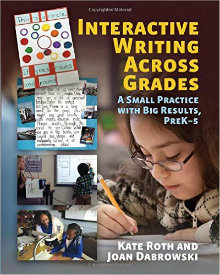Interactive Writing in the Middle Grades
Interactive Writing Across Grades: A Small Practice With Big Results, PreK-5
By Kate Roth and Joan Dabrowski
(Stenhouse, 2016 – Learn more)

Interactive writing may seem like a strange subject to be reviewing on a website devoted to the middle grades. I mean, interactive writing is for the little kids, right? Wrong!
In the authors’ own words, “Interactive writing is a powerful approach to writing instruction. Initially designed to support emergent writers, it has been used recently in upper elementary classrooms with great success.”

What’s inside
The book is very teacher friendly in the way the authors have laid out the sections. Each chapter begins with a paragraph that explains what you will find in that chapter. In this way, you can easily navigate the book based on your needs.
As the authors explain in the introduction, “This book is designed as a how-to. As you will see, we unpack the interactive writing method step by step. Our ultimate hope is that when you finish the final chapter, you will know and understand the method well enough to try it out for yourself.”
The why and how
The book is divided into three sections: an overview, working through each part of an interactive writing lesson, and how to get started.
In Section One: A First Look at Interactive Writing, there are visual examples of actual classroom work as well as “Listen In on a Lesson” sections where there are transcripts of actual interactive writing lessons from real classrooms. There are snippets of “What Teachers Are Saying” in the margins from teachers of all grade levels (PreK-5). Section one gives an overview of what interactive writing is and how it can enhance your literacy program.
In Section Two: Working Through Each Part of an Interactive Writing Lesson there are once again numerous snapshots of actual classroom work as well as “Listen In on a Lesson” sections. There are also several charts in every chapter of the section with suggestions for materials to use, experiences to write about at different grade levels in various content areas, planning points, questions to guide you, etc.
Section Three: Getting Started With Interactive Writing offers practical advice for how to start using interactive writing in your classroom tomorrow! The authors even provide you with a lesson plan template and show samples from classroom teachers.
Chapter 10 shows a finished example from each grade level (PreK-5) so all teachers can see the progression across grade levels, as well as how all of the planning and parts of the lesson fit together.
You can do it!
The conclusion is a brief recap of why you should do interactive writing as well as a note of encouragement from the authors that you can do it! The authors explain their book best themselves:
“We set out to write a straightforward ‘how-to’ book about interactive writing – a small instructional practice that yields big results for students and for you. Our goal was to introduce you to this instructionally rich and efficient method of writing instruction through words, pictures, and teachers’ voices.”
In my opinion, they did just that!
If I was asked to offer one piece of advice to the authors and their publisher, it would be that links to some how-to videos would have made the book even better! Because interactive writing has been viewed as more of a primary activity, most of the videos online seem to be of primary classes. Maybe they’ll offer some upper elementary video at the Stenhouse website!?
Pam Hamilton is an Intermediate Literacy Coach at Middlebury Community Schools in Middlebury, Indiana. She will begin her 23rd year of teaching in August, 2017. In those 23 years, she has taught 1st and 2nd grades, Reading Recovery and Title I Intervention groups before becoming a 3-5 literacy coach in 2013.


































